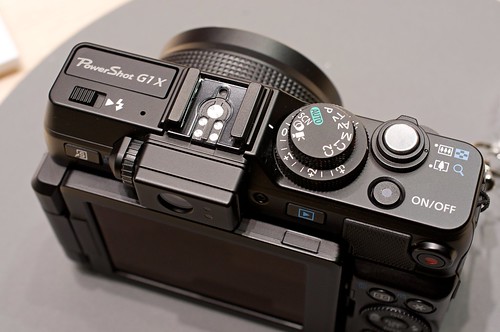Difference between revisions of "Canon PowerShot G1 X"
m (removed stub) |
m (Layout tidy up, added categories) |
||
| Line 1: | Line 1: | ||
| + | The '''PowerShot G1 X''' is a high-end compact digital camera introduced by [[Canon]] in 2012. It inherits the chunky styling, general control layout, and [[raw]]-shooting capabilities from Canon's earlier "G" models, such as the [[Canon_PowerShot_G12|G12]]. But a major difference from those predecessors is the inclusion of a significantly [[Sensor#Sensor Size|larger sensor]]: At 18.7 x 14mm it is almost full APS-C format, rather than the 1/1.7" used in most other "serious" compact cameras. Unlike typical [[DSLR]] sensors, the G1 X uses the 4:3 aspect ratio more typical of compact cameras. | ||
| + | |||
| + | In contrast to [[CSC]]s such as those using the [[Micro Four Thirds]] format, the G1 X has no interchangeable lens; instead it has a fixed 15.1–60.4 mm zoom (giving a [[35mm equivalent]] of 28–112 mm). The larger sensor format demands a proportionally larger lens; and to avoid even greater bulk Canon had to compromise on the lens's close-focus ability (for a minimum subject dimensions of about 8x10")<REF name="DPR"> See "Lens details" on [http://www.dpreview.com/reviews/canong1x/7 page 7] and "Optical viewfinder" on [http://www.dpreview.com/reviews/canong1x/5 page 5] of the [http://www.dpreview.com/reviews/canong1x DPReview.com review].</REF>, and [[Lens#Lens_Speed|speed]] (only f/5.8 when zoomed to full telephoto). This somewhat counteracts the high-ISO advantage of the G1 X's larger sensor: A compact camera with a [[Lens#Lens_Speed|brighter]] lens, (such as the [[Olympus XZ-1]] offers an aperture two stops wider when zoomed to its 112 mm -equivalent setting. | ||
| + | |||
| + | Rather than opting for one of the era's increasingly-sophisticated [[electronic viewfinder]]s, the G1 X sticks with Canon's zooming optical finder, despite its limitations<REF name="DPR"/>. However a fully articulated fold-out [[LCD]] screen of 922,000 dots resolution is also available. | ||
| + | {{Flickr_image | ||
| + | |image_source= http://www.flickr.com/photos/n00bs/6847467349/in/pool-camerawiki | ||
| + | |image= http://farm8.staticflickr.com/7024/6847467349_cc35938a4f.jpg | ||
| + | |image_align= left | ||
| + | |image_text= Top controls | ||
| + | |image_by= schaft9 | ||
| + | |image_rights= wp | ||
| + | }} | ||
{{Flickr_image | {{Flickr_image | ||
|image_source= http://www.flickr.com/photos/n00bs/6847477517/in/pool-camerawiki/ | |image_source= http://www.flickr.com/photos/n00bs/6847477517/in/pool-camerawiki/ | ||
|image= http://farm8.staticflickr.com/7066/6847477517_8bf022156b.jpg | |image= http://farm8.staticflickr.com/7066/6847477517_8bf022156b.jpg | ||
| − | |image_align= | + | |image_align= left |
|image_text= | |image_text= | ||
|image_by= schaft9 | |image_by= schaft9 | ||
| Line 9: | Line 22: | ||
}} | }} | ||
| − | + | {{br}} | |
| − | |||
| − | |||
| − | |||
| − | |||
| − | |||
==Notes== | ==Notes== | ||
<references/> | <references/> | ||
| Line 23: | Line 31: | ||
| − | + | ||
| − | |||
| − | |||
| − | |||
| − | |||
| − | |||
| − | |||
| − | |||
[[Category:Japanese digital]] | [[Category:Japanese digital]] | ||
[[Category:TIPA]] | [[Category:TIPA]] | ||
| + | [[Category:Canon]] | ||
| + | [[Category:P]] | ||
Revision as of 02:57, 28 November 2014
The PowerShot G1 X is a high-end compact digital camera introduced by Canon in 2012. It inherits the chunky styling, general control layout, and raw-shooting capabilities from Canon's earlier "G" models, such as the G12. But a major difference from those predecessors is the inclusion of a significantly larger sensor: At 18.7 x 14mm it is almost full APS-C format, rather than the 1/1.7" used in most other "serious" compact cameras. Unlike typical DSLR sensors, the G1 X uses the 4:3 aspect ratio more typical of compact cameras.
In contrast to CSCs such as those using the Micro Four Thirds format, the G1 X has no interchangeable lens; instead it has a fixed 15.1–60.4 mm zoom (giving a 35mm equivalent of 28–112 mm). The larger sensor format demands a proportionally larger lens; and to avoid even greater bulk Canon had to compromise on the lens's close-focus ability (for a minimum subject dimensions of about 8x10")[1], and speed (only f/5.8 when zoomed to full telephoto). This somewhat counteracts the high-ISO advantage of the G1 X's larger sensor: A compact camera with a brighter lens, (such as the Olympus XZ-1 offers an aperture two stops wider when zoomed to its 112 mm -equivalent setting.
Rather than opting for one of the era's increasingly-sophisticated electronic viewfinders, the G1 X sticks with Canon's zooming optical finder, despite its limitations[1]. However a fully articulated fold-out LCD screen of 922,000 dots resolution is also available.

|
| Top controls image by schaft9 (Image rights) |

|
| image by schaft9 (Image rights) |
Notes
- ↑ 1.0 1.1 See "Lens details" on page 7 and "Optical viewfinder" on page 5 of the DPReview.com review.
Links
- Canon G1 X review at DPReview.com
- Another review at Camera Labs (New Zealand)
- Canon G1 X manufacturer's page at Canon USA